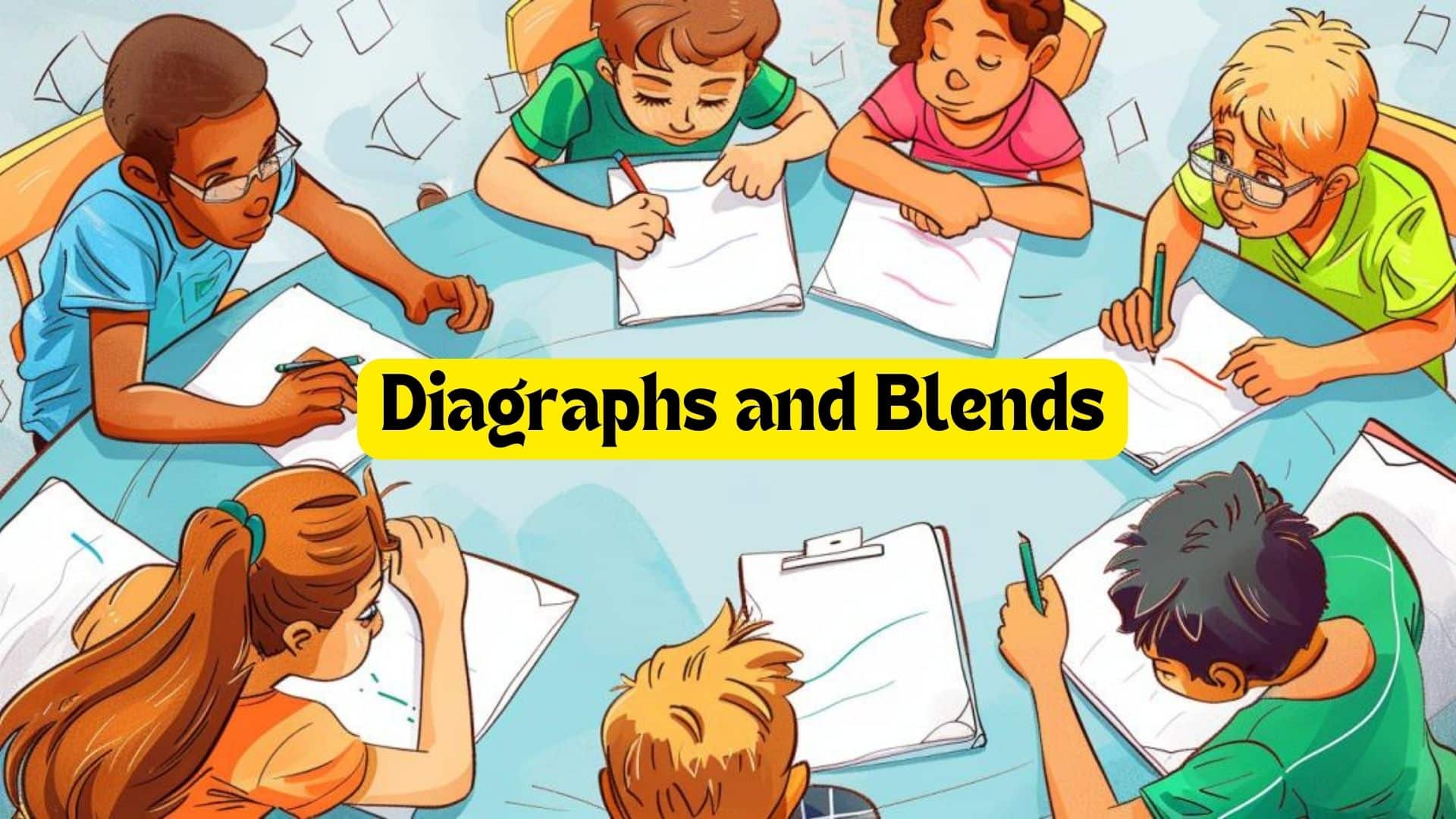Learning to read and write can be a fun adventure for kids, but some letter combinations prove more difficult than others.
Digraphs and blends, where two or more letters team up to create distinct sounds, often confuse young learners.
However, with the right approach and engaging activities, children can conquer these tricky letter pairings and become confident readers and spellers.
This post will explore the world of digraphs and blends, helping you guide your child to success.
We’ll discuss the different types of digraphs and blends, provide examples of simple words to practice and share tips and activities to make learning enjoyable.
By the end, you’ll have a toolkit of strategies to help your child master digraphs and blends easily.
Overview of Digraphs and Blends

Digraphs and blends are two important concepts in the English language that help children develop strong reading and spelling skills.
Digraphs are two letters that join forces to create a single, distinct sound.
For example, the letters ‘sh’ in “ship” and ‘ch’ in “chop” work together to produce unique sounds that differ from the individual letters.
Recognizing and understanding digraphs is crucial for children as they learn to decode words accurately, leading to improved reading fluency and spelling abilities.
On the other hand, blends are two or three consonants that are pronounced together, with each consonant maintaining its sound.
Common blends include ‘bl’ in “blue” and ‘str’ as in “street.”
Mastering blends helps children read more smoothly and quickly and spell words correctly.
Common Types of Digraphs
1. Consonant Digraphs
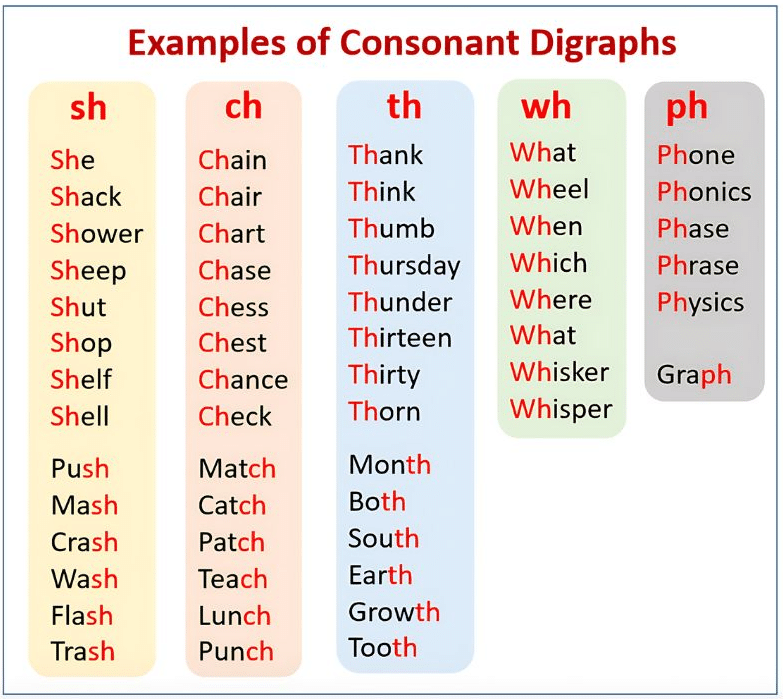
Consonant digraphs are pairs of consonants that combine to create a single sound that differs from the individual sounds of the letters.
These unique sounds help children read and spell words more accurately.
Let’s explore some common consonant digraphs:
- ‘Sh’: This digraph is found in words like “she” and “wish,” producing a soft, hushing sound. When teaching this digraph, focus on its specific sound and provide examples of words that feature it.
- ‘Ch’: The’ ch’ digraph, which appears in words such as “chair” and “chat,” creates a choppy, hard sound. Help children recognize this sound by using visual aids like flashcards with images and words that highlight the digraph.
- ‘Th’: The ‘th’ digraph, found in words like “think” and “throw,” can produce either a voiced sound (as in “this”) or an unvoiced sound (as in “think”). To teach this digraph, use auditory activities where children listen to words and identify the specific ‘th’ sound.
When teaching consonant digraphs, it’s essential to focus on their sounds rather than just the letters themselves.
Provide lists of common words that use each digraph and practice reading them aloud to reinforce the connection between the digraph and its sound.
2. Vowel Digraphs
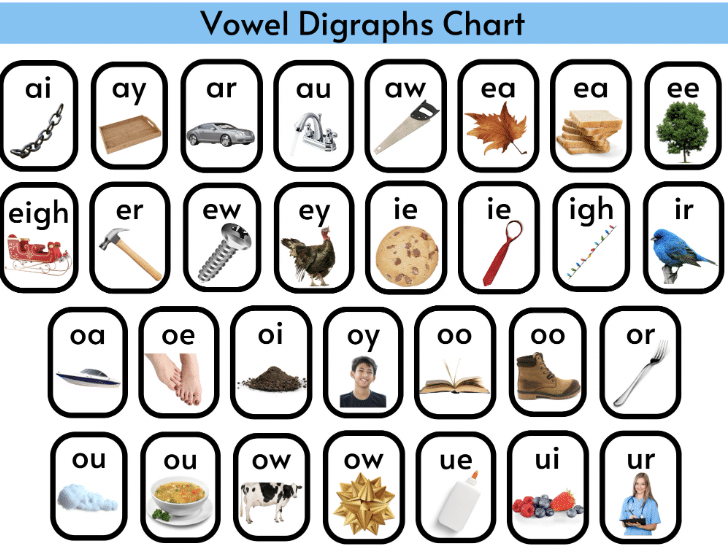
Vowel digraphs are pairs of vowels that work together to produce a single vowel sound.
These digraphs can be tricky for children to master, as their sounds may differ from the individual vowel sounds.
Here are some examples of vowel digraphs:
- ‘Ai’: This digraph is found in words like “rain” and “gain,” producing a long ‘a’ sound. To help children recognize this digraph, highlight common words that contain it and practice reading and spelling them.
- ‘Ea’: Appearing in words such as “read” (as in “reed”) and “beach,” the ‘ea’ digraph can produce different sounds depending on the word. Use word walls and charts to display examples of the ‘ea’ digraph in various contexts to help children understand its versatility.
When teaching vowel digraphs, focus on frequently used words that contain these letter combinations.
Provide lists of words that include the target vowel digraphs and have children practice reading and spelling them to reinforce their understanding.
3. Split Digraphs
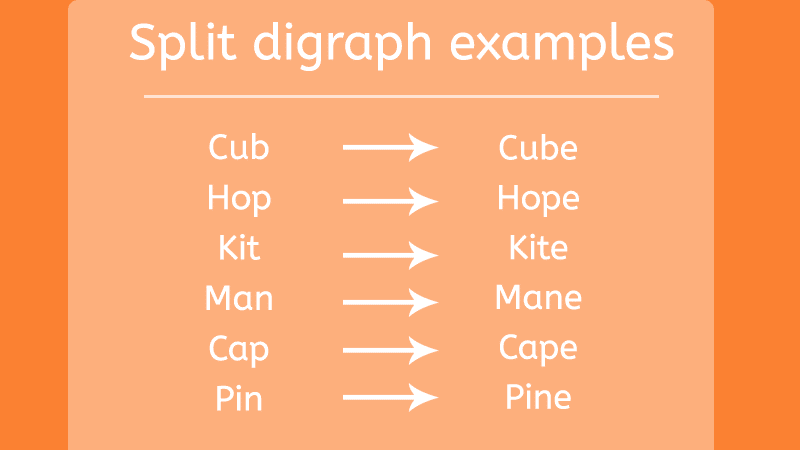
Split digraphs, also known as magic ‘e’ or silent ‘e,’ involve a vowel and a silent ‘e’ separated by a consonant.
The silent ‘e’ changes the preceding vowel sound from a short vowel sound to a long vowel sound.
Here are some examples of split digraphs:
- ‘A-e’: This split digraph turns words like “hat” into “hate” and “mat” into “mate,” changing the short ‘a’ sound to a long ‘a’ sound.
- ‘I-e’: Words like “kit” become “kite” and “bit” becomes “bite” with the addition of the silent ‘e,’ transforming the short ‘i’ sound into a long ‘i’ sound.’o-e’: The split digraph ‘o-e’ changes words like “not” into “note” and “hop” into “hope,” turning the short ‘o’ sound into a long. ‘
To effectively teach split digraphs, use simple diagrams to demonstrate how the silent ‘e’ changes the vowel sound.
Provide word pairs that illustrate the transformation, such as “tap” vs. “tape,” to help children understand the concept.
Engage children in activities where they transform short vowel words into long vowel words by adding a silent ‘e’ to reinforce their understanding of split digraphs.
Common Types of Blends
1. Initial Consonant Blends

Initial consonant blends are pairs of consonants that appear at the beginning of words, where each consonant retains its distinct sound.
These blends can be challenging for children to master, as they require the ability to combine two separate sounds smoothly.
Let’s take a closer look at some common initial consonant blends:
- ‘Bl’: This blend is found in words like “blue” and “black.” When pronouncing words with ‘bl,’ the ‘b’ and ‘l’ sounds are blended, but each sound remains distinguishable.
- ‘Cr’: Words like “crab” and “cry” feature the ‘cr’ blend. The ‘c’ and ‘r’ sounds blend, but both sounds can still be heard.
When teaching initial consonant blends, start with simple, common words to help children become familiar with the concept.
As they gain confidence, they gradually introduce more complex words and longer blends.
Visual aids like flashcards and charts that showcase initial blends in different words can help children visualize and remember these sound combinations.
2. Final Consonant Blends
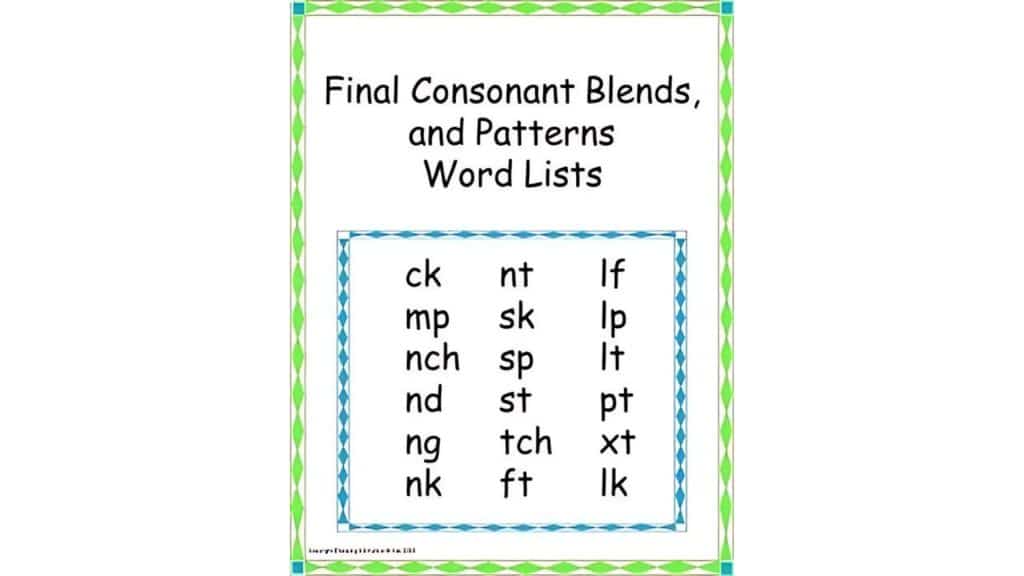
Final consonant blends are pairs of consonants that appear at the end of words, with each consonant retaining its sound.
Like initial blends, final blends require children to blend sounds while maintaining the integrity of each sound.
Here are some examples of final consonant blends:
- ‘Nt’: This blend is found in words like “ant” and “paint.” When saying these words, both the ‘n’ and ‘t’ sounds are pronounced distinctly at the end of the word.
- ‘St’: Words like “fast” and “list” feature the ‘st’ blend. The ‘s’ and ‘t’ sounds are heard at the end of the word.
To effectively teach final consonant blends, focus on the ending sounds of words to help children recognize these blends.
Use a combination of visual aids, such as word cards, and auditory methods, like repetition, to reinforce learning.
3. Three-Letter Blends
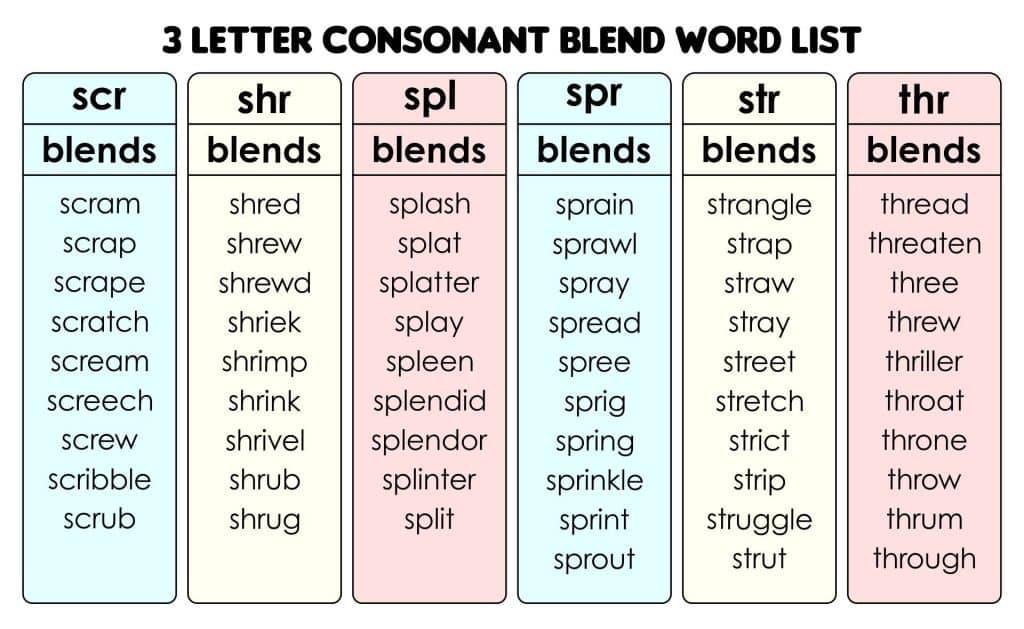
Three-letter blends are groups of three consonants that appear together in a word, each contributing its distinct sound.
These blends can be tricky for children, as they quickly blend three separate sounds.
Let’s explore some examples of three-letter blends:
- ‘Str’: This blend is found in words like “string” and “street.” When pronouncing these words, all three consonants, ‘s,’ ‘t,’ and ‘r,’ are articulated in sequence, creating a complex sound.
- ‘Spl’: Words like “splash” and “split” feature the ‘spl’ blend. Each consonant ‘s,’ ‘p,’ and ‘l’ contributes to the blend, requiring children to combine the sounds carefully.
Teaching three-letter blends involves breaking down the blend into its sounds and then practicing blending them.
Encourage children to say and blend each sound separately, building up speed and fluency over time.
Common Mistakes and How to Avoid Them
1. Pronunciation Errors
When learning digraphs and blends, children may encounter several common pronunciation errors that hinder their reading and speaking progress.
For digraphs, one frequent mistake is mispronouncing ‘sh’ as separate ‘s’ and ‘h’ sounds instead of the correct, smooth ‘sh’ sound.
Another error is confusing the ‘ch’ digraph with the ‘k’ or ‘sh’ sounds, leading to incorrect pronunciations.
Additionally, children might struggle with the ‘th’ digraph, either by saying ‘t-h’ instead of the proper sound or by using the wrong variation of ‘th’ (voiced, as in “this,” vs. unvoiced, as in “think”).
In the case of blends, a common mistake is dropping one of the consonants, particularly in blends like ‘bl,’ ‘cr,’ or ‘str.’
For example, a child might say “bue” instead of “blue,” omitting the ‘l’ sound.
Another issue is blending the sounds too quickly or too slowly, resulting in unclear or distorted pronunciations.
Tips to Correct These Pronunciation Errors
- Repetition: Encourage children to practice saying words with digraphs and blends repeatedly. This repetition helps build muscle memory and familiarity with the correct sounds and pronunciations.
- Listening Exercises: Use audio recordings that demonstrate the correct pronunciations of words containing digraphs and blends. Have children listen to these recordings and repeat the words, focusing on mimicking the proper sounds.
- Phonics Drills: Engage children in phonics drills where they break down words into individual sounds and then blend them together correctly. This practice helps reinforce the proper pronunciation of digraphs and blends within words.
- Visual Cues: Employ visual aids, such as mouth diagrams, that show children how to position their tongue and lips to produce the correct sounds. These visual cues can be particularly helpful for tricky digraphs like ‘th.’
2. Spelling Mistakes
In addition to pronunciation errors, children often make spelling mistakes when writing words that contain digraphs and blends.
Common digraph-related spelling mistakes include:
- Spelling “ship” as “sip” by omitting the ‘h’
- Writing “chair” as “chare” by confusing similar sounds
- Misspelling “think” as “tink” by dropping the ‘h’
Frequent blend-related spelling errors include:
- Spelling “blue” as “bue” by leaving out the ‘l’
- Writing “crab” as “cab” by missing the ‘r’
- Misspelling “street” as “stret” by omitting the ‘e.’
Strategies to Improve Spelling Accuracy
- Writing Practice: Provide regular opportunities for children to practice writing words that contain digraphs and blends. This focused writing practice can help reinforce correct spelling patterns.
- Spelling Games: Incorporate games like word searches, crossword puzzles, and spelling bees to make learning fun and engaging. These activities encourage children to pay close attention to the correct spelling of words while enjoying the learning process.
- Word Lists: Supply children with lists of words that feature common digraphs and blends. Encourage them to practice spelling and using these words in sentences to promote mastery.
- Memory Aids: Teach children mnemonic devices and memory aids to help them remember tricky spellings. For example, the phrase “I before E except after C” can help with words like “receive” and “achieve.”
Conclusion
Mastering digraphs and blends is crucial in your child’s reading and writing journey.
By understanding digraphs and blends and using strategies to fix common pronunciation and spelling mistakes, you can help your child build a strong foundation in language skills.
Remember, practice makes a man perfect! Encourage your child to engage with digraphs and blends through fun activities, games, and regular reading and writing exercises.
With your support and guidance, your child will soon be confidently navigating the world of digraphs and blends, unlocking a lifetime of reading and writing success.
Put these tips into action and watch your child’s language skills improve!

